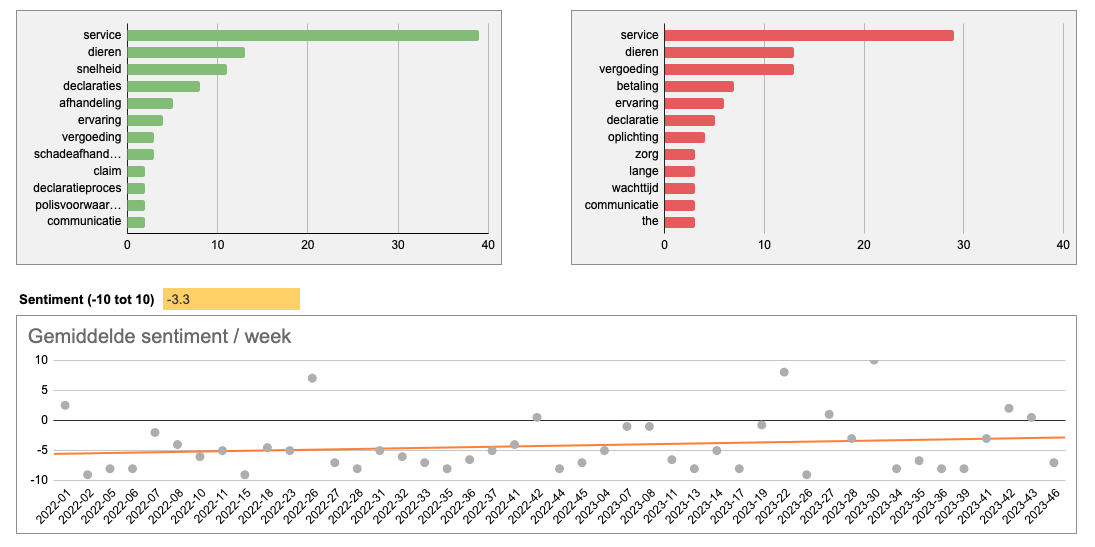Much mentioned but not always a clear guideline on how to apply it in your customer research. Here are three common Prompts I use to classify the customer feedback. Topic modeling, Customer sentiment, Emotional Value Index.
What methods to use with AI?
Topic modeling: Topic modeling is an advanced artificial intelligence technique designed to automatically assign tags or topics to content. By analyzing the textual data, the AI identifies patterns and recurring themes within the content, allowing it to categorize and label the information accordingly. This automated process streamlines content organization, facilitates information retrieval, and enhances data analysis in various fields such as natural language processing, information retrieval, and machine learning.
Customer sentiment:Customer sentiment is a metric used to evaluate the emotional tone of content, typically ranging from -10 to 10. This score reflects whether the content evokes positive or negative feelings among customers. By assigning a numerical value to sentiment, businesses can gauge the overall perception of their products, services, or brand, helping them make informed decisions to enhance customer satisfaction and loyalty.
Emotional Value Index:The Emotional Value Index is a metric that quantifies the emotional significance or impact of various experiences, interactions, or stimuli. Scores range between -100 and 100 for each emotion, providing a nuanced understanding of emotional responses. For instance, a score of ‘Frustration 100’ indicates maximum frustration, while ‘Trust -50’ suggests a significant lack of trust. This index offers a structured framework to analyze and interpret the emotional dimensions of diverse situations, aiding in decision-making, product design, and psychological research.
Create your own Voice of the Customer analyses with AI
Step 1: Voice of the customer
Get yourself your customer feedback in Google Sheets. You can make an export from you Survey tool like Mopinion or Hotjar. Or you can even extract reviews. from known platforms like Trustpilot or Tripadvisor with Javascript.
Step 2: Plugin in Google sheets
Install the plugin for google sheets with ChatGPT for your Google Sheet
Step 3: ChatGPT account
Make sure you have an account for ChatGPT and create aChat GPT API Key. You need to add this API Key in the Google-sheets plugin to communicate with ChatGPT.
Step 4: Build your sheet
Columns: Time-stamp;Customer feedback;Percentages(positive,neutral,negative);Tags(positive,negative); Word count (to judge value of content);Rating(Star, Grade from platform);Sentiment(-10 to 10); Emotional Value Index(EVI);

Step 5: Build your prompts
Examples:
=GPT(“What percentage of the message is positive? Respond in the format ‘0.0%'”, B2, 0.8, 4, “gpt-3.5-turbo”)
= GPT(“Evaluate this text and create tags for topics on why this customer is leaving a review. Respond only with tags in Dutch separated by a ‘;’ and a maximum of 3 tags.”, B2, 0.8, 500, “gpt-3.5-turbo”)
=IFERROR(GPT(“Assign a sentiment value to the message between -10 and 10, where -10 is negative and 10 is positive”, B2, 0.8, 500, “gpt-3.5-turbo”), 0)
Step 6: Personal check
Make sure you build in some validation columns so you can modify the answers according to your own professional opinion.

Field to manually edit the result
Field to manually add tags
Step 7: Build your visualization
There are many ways you can analyze customer feedback.

Visual of reviews
No time to build it yourself? Upload your reviews or customer feedback here and I will give you an example with your customer feedback.



